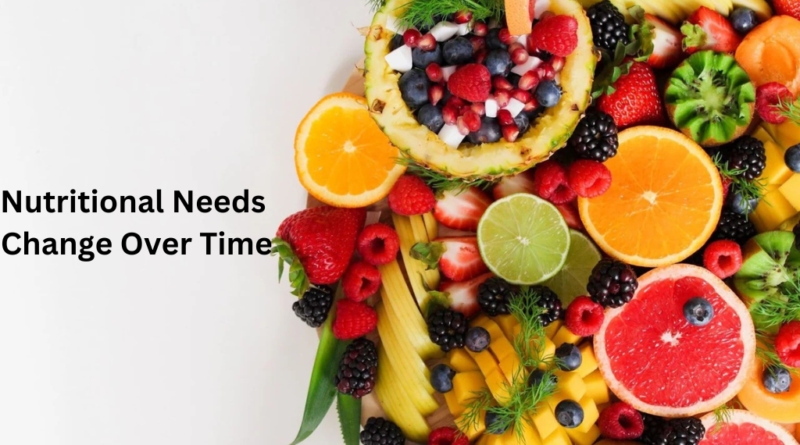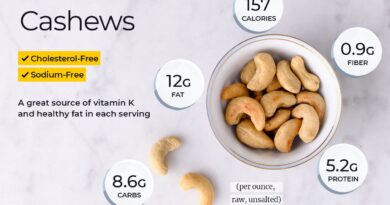How Do Nutritional Needs Change Over Time: Essential Insights
Nutritional needs change as we age. Each life stage has unique dietary requirements.
As children, our bodies need nutrients for growth and development. Teens require more energy and protein to support rapid physical changes. Adults need balanced diets to maintain health and prevent chronic diseases. Seniors have different needs, focusing on nutrient-dense foods for overall well-being.
Understanding how nutritional needs evolve helps us make better food choices at each stage of life. It ensures we get the right nutrients to support our body’s changing needs. So, let’s explore how our diet should adjust as we move through different phases of life. This knowledge can guide you in making informed, healthy choices every day.
Life Stages And Nutrition
Understanding how nutritional needs change over time is crucial for maintaining good health. Throughout different life stages, our bodies require specific nutrients to function optimally. Each stage, from infancy to old age, has unique dietary needs. Let’s explore how nutrition varies across different life stages.
Infancy And Early Childhood
During infancy and early childhood, nutrition is vital for growth and development. Babies need a diet rich in essential nutrients to support rapid growth. Breast milk or formula provides the perfect balance of nutrients for infants. As they grow, their dietary needs evolve. Here are key nutrients for infants and young children:
- Protein: Essential for growth and tissue repair.
- Iron: Important for brain development and preventing anemia.
- Calcium: Crucial for bone growth and development.
- Vitamins A, C, and D: Support immune function, skin health, and bone development.
Introducing solid foods around six months is also important. Start with iron-fortified cereals, pureed vegetables, and fruits. Gradually introduce a variety of foods to ensure a balanced diet. By age two, children should eat from all food groups:
- Fruits and vegetables
- Grains
- Proteins
- Dairy
Proper nutrition during these early years sets the foundation for a healthy life. It helps prevent deficiencies and supports overall development.
Adolescence And Growth
Adolescence is a time of rapid growth and development. Teenagers experience significant physical changes, and their nutritional needs increase. They need more calories, protein, vitamins, and minerals to support this growth. Key nutrients for adolescents include:
- Protein: Supports muscle growth and repair.
- Calcium and Vitamin D: Essential for bone development and peak bone mass.
- Iron: Important for muscle growth and increased blood volume.
- Folate: Supports DNA production and cell division.
Healthy eating habits are crucial during adolescence. Encourage a diet rich in fruits, vegetables, whole grains, and lean proteins. Limit sugary drinks and snacks to prevent unhealthy weight gain. A balanced diet supports physical growth and cognitive development. Regular physical activity is also important. It helps build strong bones and muscles. It also promotes mental well-being and healthy weight management. Here’s a simple table for daily nutrient recommendations for adolescents:
| Nutrient | Daily Recommendation |
|---|---|
| Protein | 46-52 grams |
| Calcium | 1300 mg |
| Iron | 11-15 mg |
| Folate | 400 mcg |
Meeting these nutritional needs helps adolescents transition into healthy adults. It ensures they develop properly and maintain long-term health.

Nutritional Needs In Adulthood
As we journey through life, our nutritional needs evolve. In adulthood, maintaining a balanced diet becomes crucial for health and well-being. Adults need to focus on nutrition to support their body’s changing requirements. This ensures energy levels remain high and disease risks stay low. Understanding these needs can help in making informed dietary choices.
Maintenance Of Health
Maintaining health in adulthood requires a conscious effort to consume a variety of nutrients. Adults need a diet rich in vitamins, minerals, protein, and healthy fats. Key nutrients include:
- Calcium – Crucial for bone health. Adults should aim for 1,000 mg per day.
- Vitamin D – Helps in calcium absorption. Recommended intake is 600 IU per day.
- Fiber – Aids digestion and prevents constipation. Men need 38 grams and women need 25 grams daily.
- Protein – Supports muscle maintenance and repair. Aim for 46 grams for women and 56 grams for men each day.
Staying hydrated is also essential. Adults should drink at least 8 cups of water daily. Water helps regulate body temperature and supports metabolic processes. A balanced diet can prevent chronic diseases such as diabetes, heart disease, and osteoporosis. To maintain health, adults should limit the intake of:
- Processed foods
- Sugary drinks
- High-sodium snacks
Regular check-ups with healthcare providers can help monitor nutritional needs. Adjusting the diet based on medical advice ensures long-term health benefits.
Dietary Adjustments
As adults age, their metabolism slows down. This means the body needs fewer calories but still requires essential nutrients. Making dietary adjustments is key to meeting these changing needs. Consider the following tips:
- Smaller Portions – Eating smaller, more frequent meals can help maintain energy levels and prevent overeating.
- More Fruits and Vegetables – Aim for at least 5 servings per day. These provide vitamins, minerals, and fiber.
- Whole Grains – Replace refined grains with whole grains like brown rice, quinoa, and whole wheat bread.
Protein needs can be met by including various sources such as:
| Source | Protein Content |
|---|---|
| Chicken Breast | 31 grams per 100 grams |
| Lentils | 9 grams per 100 grams |
| Tofu | 8 grams per 100 grams |
Reducing sodium intake is vital. Excess salt can lead to high blood pressure. Adults should aim for less than 2,300 mg of sodium per day. Using herbs and spices to flavor food can reduce reliance on salt. Incorporating these dietary adjustments ensures adults get the nutrients they need while managing calorie intake. This promotes a healthy weight and supports overall well-being.
Impact Of Aging
As we age, our bodies undergo numerous changes. These changes affect our nutritional needs. Understanding these changes is crucial for maintaining good health. The impact of aging on nutrition is significant. It influences metabolism, nutrient absorption, and overall dietary requirements. Let’s explore how aging impacts our nutritional needs.
Metabolism Changes
Aging slows down our metabolism. This means our bodies burn fewer calories. Reduced physical activity often accompanies this slowdown. This can lead to weight gain. It’s essential to adjust our diet to match our metabolic rate. Here are some key points:
- Caloric Needs: Older adults need fewer calories. This helps prevent weight gain.
- Protein Intake: Protein becomes more important. It helps maintain muscle mass.
- Fiber: Higher fiber intake aids digestion. It also helps prevent constipation.
A balanced diet is crucial. Here’s a simple table to guide you:
| Nutrient | Recommended Intake |
|---|---|
| Calories | 1,800 – 2,200 (depending on activity level) |
| Protein | 50 – 60 grams |
| Fiber | 25 – 30 grams |
Staying active is also important. Regular exercise can boost metabolism. Simple activities like walking can make a big difference. Remember, adjust your diet and activity level as you age. This helps maintain a healthy weight and overall well-being.
Common Nutritional Deficiencies
Aging can lead to nutritional deficiencies. This is due to various factors. Reduced appetite, medication, and poor nutrient absorption are common causes. Here are some common deficiencies in older adults:
- Vitamin D: Essential for bone health. Deficiency can lead to osteoporosis.
- Calcium: Works with Vitamin D. Important for strong bones and teeth.
- Vitamin B12: Supports nerve function and red blood cell production.
- Iron: Prevents anemia. Helps carry oxygen in the blood.
- Magnesium: Supports muscle and nerve function. Helps regulate blood sugar levels.
Addressing these deficiencies is vital. Here’s how you can ensure adequate intake:
- Vitamin D: Get sunlight exposure. Eat fortified foods and take supplements.
- Calcium: Consume dairy products, leafy greens, and fortified foods.
- Vitamin B12: Eat meat, fish, dairy products, and fortified cereals.
- Iron: Include lean meats, beans, and fortified grains in your diet.
- Magnesium: Eat nuts, seeds, whole grains, and leafy greens.
Regular check-ups can help identify deficiencies early. Consult with a healthcare provider for personalized advice. Proper nutrition is key to healthy aging. Pay attention to your body’s needs and adjust your diet accordingly.

Pregnancy And Lactation
During pregnancy and lactation, a woman’s body undergoes significant changes. These changes impact nutritional needs, making it essential to understand how to meet them. Proper nutrition supports the health of both the mother and the developing baby. Let’s explore the specific nutritional demands and needs during these crucial stages.
Increased Nutritional Demands
Pregnancy increases the body’s demand for essential nutrients. These nutrients support fetal growth, maternal tissue expansion, and increased blood volume. Ensuring adequate intake of vitamins and minerals is vital. Key nutrients include:
- Folic Acid: Essential for preventing neural tube defects. Recommended intake is 600-800 mcg daily.
- Iron: Supports increased blood volume and prevents anemia. Pregnant women need 27 mg per day.
- Calcium: Crucial for fetal bone development. Aim for 1,000 mg daily.
- Protein: Supports tissue growth for both mother and baby. Intake should be around 75-100 grams per day.
- Omega-3 Fatty Acids: Important for brain development. Include sources like fish oil or flaxseeds.
These nutrients can be found in a balanced diet that includes:
| Food Group | Examples |
|---|---|
| Fruits and Vegetables | Broccoli, spinach, oranges, berries |
| Whole Grains | Oats, brown rice, whole wheat bread |
| Lean Proteins | Chicken, eggs, beans, lentils |
| Dairy | Milk, yogurt, cheese |
| Healthy Fats | Avocado, nuts, seeds |
Maintaining a healthy diet with these food groups ensures the mother gets the necessary nutrients. Supplements may also be recommended by healthcare providers to meet these increased demands.
Postpartum Nutritional Needs
After childbirth, the body needs time to recover and heal. Proper nutrition supports this recovery and aids in producing quality breast milk for lactating mothers. Key nutrients for postpartum women include:
- Iron: Continues to be important to replenish blood lost during delivery. Aim for 15-18 mg daily.
- Calcium: Essential for bone health, especially if breastfeeding. Continue with 1,000 mg daily.
- Protein: Supports tissue repair and milk production. Aim for 65-70 grams per day.
- Fluids: Increased hydration supports milk production. Drink at least 10-12 cups of water daily.
Dietary choices should focus on:
- Whole grains for sustained energy.
- Fruits and vegetables for vitamins and minerals.
- Lean proteins to aid tissue repair.
- Healthy fats for overall health.
Breastfeeding mothers may need to consume an additional 500 calories per day. This helps meet the energy demands of milk production. Here’s a sample meal plan for a day:
| Meal | Examples |
|---|---|
| Breakfast | Oatmeal with berries and nuts, a glass of milk |
| Lunch | Grilled chicken salad with mixed greens and avocado, whole grain bread |
| Snack | Yogurt with fruit and a handful of almonds |
| Dinner | Baked salmon, quinoa, steamed broccoli |
| Snack | Apple slices with peanut butter |
Postpartum nutrition is crucial for recovery and supporting the demands of lactation. A well-rounded diet helps ensure both mother and baby receive the necessary nutrients.
Chronic Conditions And Nutrition
Nutritional needs change as we age, influenced by various factors including chronic conditions. Chronic conditions such as diabetes and heart disease require specific dietary adjustments to manage symptoms and improve overall health. Understanding the role of nutrition in these conditions helps in making informed dietary choices that support long-term well-being.
Diabetes Management
Diabetes requires careful management of blood sugar levels. Nutrition plays a crucial role in this process. For those with diabetes, it is important to:
- Monitor carbohydrate intake
- Choose complex carbohydrates over simple sugars
- Include fiber-rich foods in every meal
- Balance meals with proteins and healthy fats
A balanced diet helps in maintaining stable blood sugar levels. Here is a simple table outlining healthy food choices:
| Food Type | Recommended Choices |
|---|---|
| Carbohydrates | Whole grains, vegetables, legumes |
| Proteins | Lean meats, fish, tofu, beans |
| Fats | Avocado, nuts, olive oil |
Also, it is important to avoid sugary drinks and snacks. These can cause rapid spikes in blood sugar levels. Regular meals and snacks help in preventing these spikes. Consistency is key for effective diabetes management.
Heart Health Considerations
Heart health is greatly influenced by dietary habits. For those with heart conditions, a heart-healthy diet can help in managing symptoms and improving quality of life. Key dietary recommendations include:
- Reducing saturated and trans fats
- Limiting salt intake
- Increasing consumption of fruits and vegetables
- Choosing whole grains over refined grains
Here’s a useful table to guide heart-healthy food choices:
| Food Type | Recommended Choices |
|---|---|
| Fats | Olive oil, flaxseeds, fatty fish |
| Proteins | Lean poultry, beans, lentils |
| Grains | Oats, quinoa, brown rice |
Limiting processed foods is also important. These foods often contain high levels of sodium and unhealthy fats. Regular physical activity complements a heart-healthy diet, contributing to overall cardiovascular health. Small dietary changes can make a big difference in heart health management.
Cultural Influences On Diet
Nutritional needs change as we age. Cultural influences play a big role in our diets. These influences shape our food choices and eating habits. Different cultures have unique diets that evolve over time. Let’s explore how traditional diets and modern adaptations impact our nutrition.
Traditional Diets
Traditional diets are passed down through generations. These diets include local and seasonal foods. They are often balanced and nutrient-rich. Here are some examples of traditional diets:
- Mediterranean Diet: Includes fruits, vegetables, whole grains, and olive oil. Fish and poultry are consumed more than red meat.
- Japanese Diet: Emphasizes rice, fish, vegetables, and soy products. It is low in fat and high in fiber.
- Indian Diet: Features lentils, rice, vegetables, and spices. It includes a variety of plant-based foods.
These diets have common features:
| Feature | Description |
|---|---|
| Fresh Ingredients | Locally sourced, seasonal, and minimally processed. |
| Balanced Meals | Include a mix of carbohydrates, proteins, and fats. |
| Portion Control | Smaller portions that help maintain a healthy weight. |
Traditional diets help maintain health and prevent diseases. They are rich in essential nutrients. These diets are also environmentally friendly. They rely on local produce and sustainable practices.
Modern Adaptations
Modern adaptations of traditional diets are common. People adapt their diets to fit busy lifestyles. Convenience and availability influence these changes. Here are some examples:
- Convenience Foods: Ready-to-eat meals and snacks. These are often high in sugar, salt, and unhealthy fats.
- Fusion Cuisine: Combines elements from different cultures. It creates new and unique dishes.
- Plant-Based Alternatives: Includes meat substitutes and dairy-free products. These cater to dietary preferences and restrictions.
Modern adaptations affect nutrition in various ways:
| Change | Impact |
|---|---|
| Processed Foods | Often high in calories, low in nutrients. |
| Fast Food | Convenient but usually unhealthy. |
| Dietary Supplements | Used to fill nutritional gaps. |
Modern diets offer more choices but come with challenges. It’s important to balance convenience with health. Choosing whole, unprocessed foods can improve nutrition. Adapting traditional diets to modern life can be healthy and sustainable.
Nutritional Trends And Myths
Introduction paragraph about How Do Nutritional Needs Change Over Time and Nutritional Trends and Myths…
Fad Diets
Fad diets come and go. They promise quick weight loss or other health benefits. Many people follow them without understanding their impact. Some common fad diets include:
- Keto diet: High-fat, low-carb, forces the body to burn fat for energy.
- Paleo diet: Focuses on foods available to ancient humans, like meat, fish, fruits, and veggies.
- Detox diets: Claim to cleanse the body, often involve juices or fasting.
Fad diets can be harmful. They often lack essential nutrients. They may lead to short-term weight loss but are hard to maintain. This causes weight gain once people stop the diet. Consider the risks versus benefits:
| Diet | Potential Benefits | Risks |
|---|---|---|
| Keto | Quick weight loss, reduced blood sugar | High cholesterol, nutrient deficiencies |
| Paleo | Improved nutrient intake, fewer processed foods | Expensive, lacks grains and dairy |
| Detox | Short-term weight loss, increased fruit and veggie intake | Muscle loss, energy drop, nutrient deficiencies |
Before starting any diet, consult with a healthcare professional. Ensure it meets your nutritional needs and is safe to follow long-term.
Evidence-based Practices
Evidence-based practices are based on research. They offer long-term health benefits. These practices include balanced diets and regular physical activity. Key evidence-based practices:
- Balanced diet: Includes a variety of foods from all food groups.
- Regular meals: Eating at regular intervals helps maintain energy levels.
- Hydration: Drinking enough water is essential for all bodily functions.
Research supports these practices. A balanced diet provides all essential nutrients. It includes:
- Fruits and vegetables
- Whole grains
- Lean proteins
- Healthy fats
Regular meals prevent overeating and keep metabolism steady. Hydration is key for digestion, temperature control, and joint health. These practices are sustainable. They fit into daily life and do not require drastic changes. They also adjust to changing nutritional needs over time. For example, children need more protein for growth. Adults need more fiber for digestion. Older adults need more calcium for bone health. Focus on these evidence-based practices for a healthy lifestyle. They are safe, effective, and backed by science.

Future Of Nutritional Science
As people age, their bodies undergo many changes, including shifts in nutritional needs. The future of nutritional science aims to address these changes more effectively. New research and technology promise tailored solutions to help individuals maintain optimal health throughout their lives.
Personalized Nutrition
Personalized nutrition is an emerging field that focuses on creating diet plans tailored to an individual’s unique genetic makeup, lifestyle, and health status. This approach aims to optimize health outcomes by addressing specific nutritional needs. Several factors contribute to the growing interest in personalized nutrition:
- Genetic Variability: Different people metabolize nutrients in various ways. Understanding genetic differences can help create more effective diet plans.
- Lifestyle Factors: Activity levels, stress, and sleep patterns all influence nutritional needs. Personalized nutrition considers these variables to offer more precise recommendations.
- Health Conditions: Conditions like diabetes, heart disease, and allergies require specific dietary adjustments. Personalized nutrition can help manage these conditions more effectively.
Here’s a simple table to illustrate how personalized nutrition compares to traditional dietary guidelines:
| Traditional Guidelines | Personalized Nutrition |
|---|---|
| General recommendations for the population | Specific recommendations based on individual factors |
| One-size-fits-all approach | Tailored to genetic, lifestyle, and health data |
| Broad dietary advice | Customized meal plans |
As research advances, the potential for personalized nutrition to improve health outcomes becomes more evident. This approach promises to make dietary advice more effective and relevant.
Technological Advancements
Technological advancements play a key role in the future of nutritional science. These innovations make it easier to collect and analyze data, leading to more accurate and personalized dietary recommendations. Some of the key technologies include:
- Wearable Devices: Track physical activity, sleep patterns, and caloric intake. These devices provide real-time data that can be used to tailor nutritional advice.
- Genetic Testing: Identifies genetic markers that influence metabolism and nutrient absorption. This information helps create personalized diet plans.
- AI and Machine Learning: Analyzes large datasets to identify patterns and trends. This technology helps predict nutritional needs based on individual data.
These technologies offer several benefits:
- Precision: More accurate data leads to better dietary recommendations.
- Convenience: Easy-to-use devices and apps make it simpler to track and manage nutritional needs.
- Accessibility: Technological advancements make personalized nutrition more accessible to a broader audience.
For example, a wearable device might track your daily steps, sleep quality, and caloric intake. This data can be synced with an app that uses AI to provide daily meal recommendations tailored to your specific needs. As technology continues to evolve, the potential for improving nutritional health grows. These advancements promise to make personalized nutrition more precise, convenient, and accessible.
Frequently Asked Questions
How Do Nutritional Needs Change With Age?
As we age, metabolism slows and nutrient absorption decreases. Older adults need more calcium, vitamin D, and fiber to support bone health and digestion.
What Nutrients Are Essential For Teenagers?
Teenagers require higher levels of protein, iron, and calcium. These nutrients support rapid growth, muscle development, and bone strengthening during adolescence.
Do Elderly People Need More Protein?
Yes, elderly people need more protein to maintain muscle mass and strength. Adequate protein intake helps prevent muscle loss and supports overall health.
How Does Pregnancy Affect Nutritional Needs?
During pregnancy, nutritional needs increase for both mother and baby. Important nutrients include folic acid, iron, and calcium to support development and prevent deficiencies.
Conclusion
Nutritional needs change as we age. Children’s bodies need lots of nutrients. Adults need balanced diets for energy and health. Seniors benefit from nutrient-dense foods for strength. Listen to your body. Adjust diets for optimal well-being. Eating right supports all life stages.
Stay informed, stay healthy.




